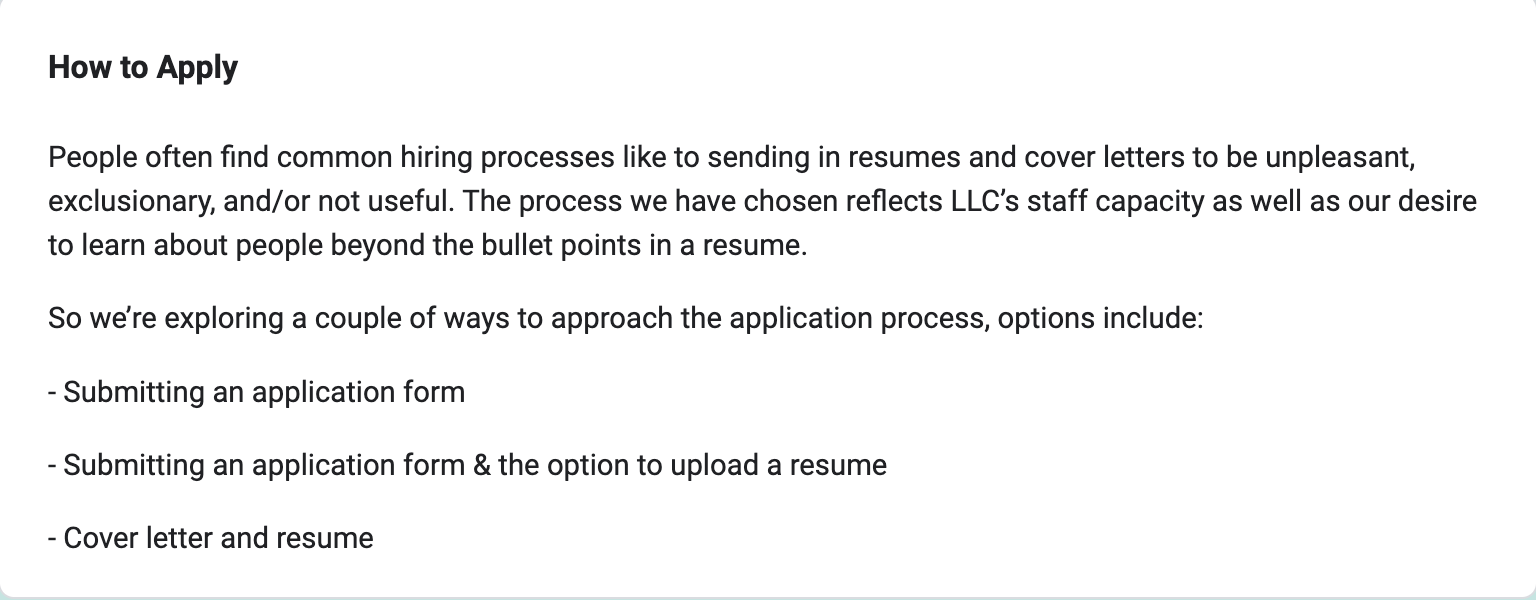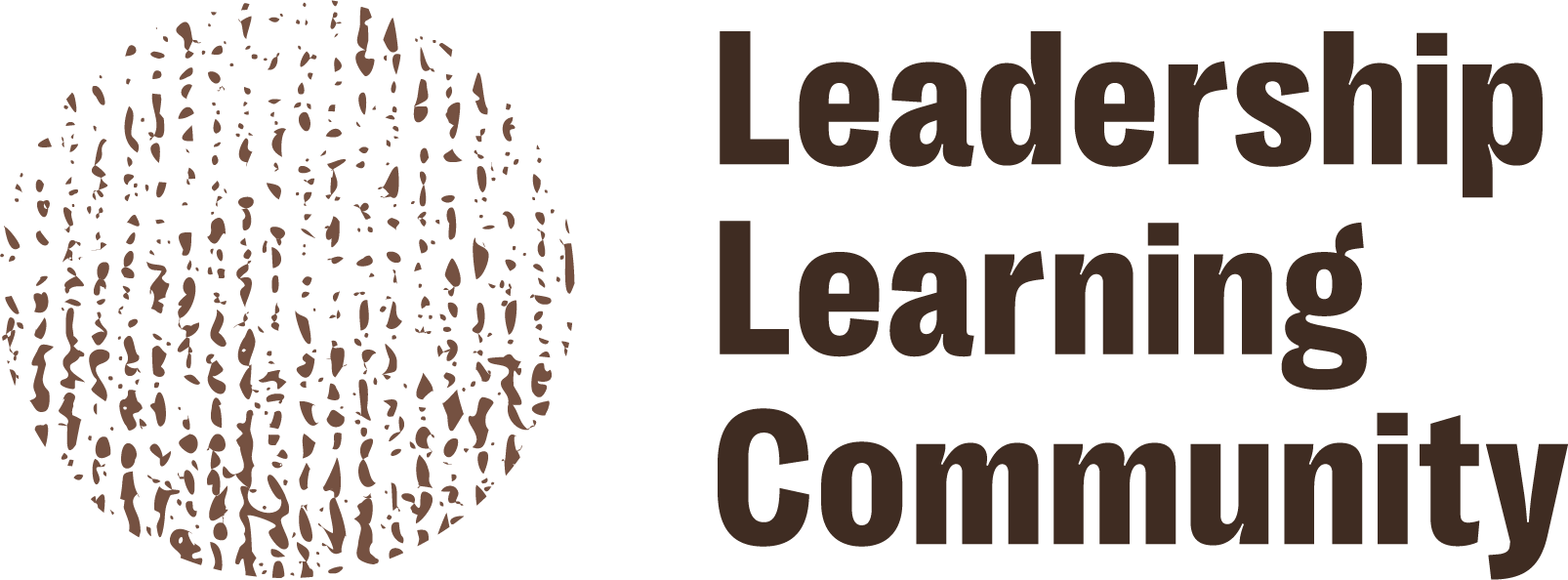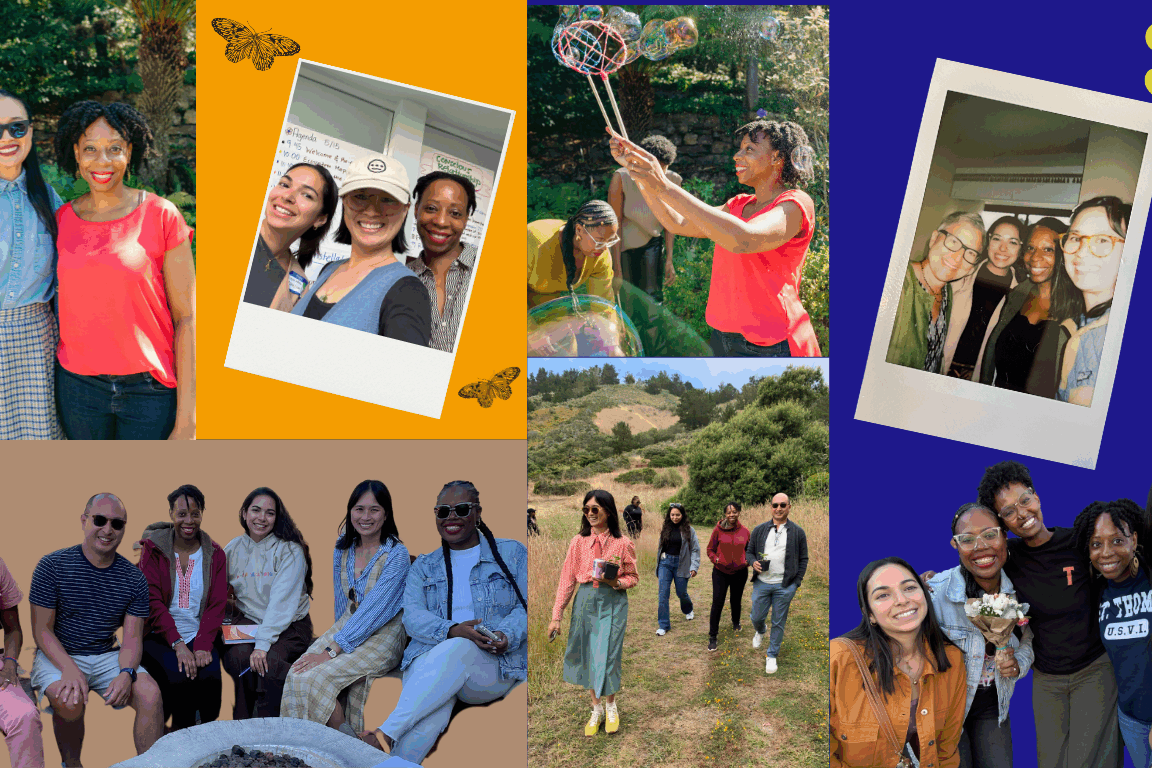By now, we all know that there are many normative hiring practices that lead to non-diverse leadership and even perpetuate harmful impacts on our communities, such as the wage gap between womxn of color and white males. For example, the US Equal Employment Opportunity Commission shares that hiring practices such as requiring applicants to pass a physical agility test or lift a certain amount of weight may have an especially negative effect on older applicants, requiring that employees live within a certain geographic region may have a negative effect on applicants of a certain race, and broadly excluding applicants with criminal records may have a negative effect on applicants based on race or national origin. Nonprofit workers we’ve talked to have also described experiencing hiring practices that completely ignore the humanity of the applicant, such as being asked to do a performance demonstration also known as an interview assignment, often busywork, that take hours to prepare for and complete without pay as part of the interview process, or completing two rounds of interviews only to never hear back on next steps or decisions. What was clear for us at LLC was the traditional hiring practices we all often default to were not very aligned with our values or mission. How can hiring be more mutual? How can we be more mindful of implicit bias? How can we invite a more diverse set of candidates to the table? As a team, we have been unlearning and learning new, liberatory ways forward.
Establishing new liberatory approaches involves a certain degree of risk. You have to put aside the “proven” way of doing things and try on new or revive older ways of doing things. Whether you are inventing or recycling, your approach will be different from the current white-dominant norm. Consequently, the track record for these efforts either may not exist or may have been obscured or erased. Knowing this, LLC adopted a learning stance in our approach to staff recruitment.
We applied the best of our knowledge about liberatory leadership, ethical and equitable HR, and other models which allow us to do just work in just ways to develop our recruitment strategy. We also invited applicants to share their thoughts about what would make our recruitment processes more liberatory. We had no idea what kind of responses we would get or if people would appreciate and understand our intentions in asking the question. We’re happy to report that in every single case, without exception, the feedback we received was in line with the spirit of the question: generous, thoughtful, and generative. If you contributed to this body of knowledge, thank you.
In this series we will share how we conducted our most recent hiring process, how we applied a liberatory lens, what went well, some things we got wrong, and what we learned from the full experience.
Our hiring process is broken down into four parts: Application Process, Interview & Screening Process, Decision-Making & Offers, and Onboarding. The writing below covers the Application and Interview processes.
Application Process
1. Establishing Internal Clarity at the Outset:
1.Set goals | Our goal was to craft an interview and screening process that addressed our needs and the needs of the people applying. We hoped the hiring process would allow us to:
-
- Get to know people
- Minimize the risk of a bad fit
- Honor and respect candidates
- Show who we really are so people know what they are getting themselves into
- Center the humanity of applicants at every stage
2.Reflect | At the beginning of the recruitment process, we reflected on the previous hiring processes we’d been a part of and LLC’s, then current, recruiting practices. We collectively identified parts of the process that could be more liberatory.
3.Outline | We then outlined the goals, expectations, and intentions for each role and then aligned the application process with our values and each role’s purpose. As we contemplated each role, we thought about how the new staff would be in relationship and align with the whole organization, not just the area or project for which we were hiring.
2. Recruiting Candidates:
- Job posting: In our recent postings (manager, coordinator), we were intentional about describing LLC’s work, our work culture, and the salary range, in addition to the standard job posting content. We focused the recruitment on inviting in the right candidates for us rather than on screening out the “wrong” candidates. We were realistic about the job, but also clear about why LLC is a great place to work. We actively invited in folx at the margins, and explicitly stated that people who may not have had this kind of opportunity in the past would be welcome.
- Where to post: We shared the available job opportunities via our website, newsletter, and through LLC’s network of friends and allied organizations. We assumed we’d eventually need to use a job posting site to generate more applications, but we actually received all of the applications we had the capacity to handle from this small universe. As a consequence of this outreach method, we didn’t have a lot of applications we could quickly dismiss because many of the applications received were close fits. While we were able to generate a diverse applicant pool, this closed method does come with some equity risks that organizations will have to account for in the process. Limiting outreach raises the risk of further marginalizing historically excluded people.
3. The Application Process:

- How to apply: We offered candidates multiple ways to apply. It’s notable that we did not offer an audio-visual submission option. Based on the learning styles of the reviewers, we knew that using an audio-visual method would disadvantage those applicants. We also didn’t have a way to account for inequitable production capacity & access.
- Incorporate a learning stance: Embed learning into the process. For example, on the application form, we asked candidates: “How can this application process be more liberatory?” While it was not always easy to pivot for candidates who had already submitted their applications, we plan to incorporate the feedback we captured in our future hiring practices. For example, one thing we are exploring for the next time we hire is making an audio/visual submission option possible by attaching written transcripts to these submissions.
4. Initial Application Review:
- Implicit bias: We made bias-checks a part of multiple stages in the process, starting with our first engagement with each candidate. We did this by intentionally prompting ourselves to do gut checks and observing patterns in our decision-making.
- Multiple reviewers: At least two staff people reviewed each application, and multiple staff informed the decisions about which candidates advanced, with the opinions of the role’s direct supervisors being more heavily weighted.
Interview & Screening Process
1. Continued Internal Learning:
- Iterate: We made time for the team to connect on a weekly or bi-weekly basis (depending on the current need) to problem-solve and readjust before the next step in the process. This real-time learning allowed us to modify the process as we went along. For example, when we realized that in one set of interviews, we asked lots of questions but didn’t have enough space for conversation, we were able to modify it in the next stage.
2. Communications:
- Set goals: We learned from previous hiring processes that a growth area for us was clear and timely communication with candidates about the hiring process and timeline. Our goal this time was to be as honest and transparent as possible in our communication with candidates, managing expectations by explaining the process and timeline with as much detail as we could.
- Communicate often and genuinely: We still made mistakes. We course-corrected in those cases when we determined our communication warranted improvement. In our communications with candidates, we also explicitly named the harm that we potentially caused when we fell short of our communication goals.
3. Interviews: We hosted 2-3 rounds of interviews with candidates
- Interview Processes: We make it a practice to send interview questions several days in advance, and timed the sending to give all candidates approximately the same amount of time to reflect on the questions: Allowing candidates time to think about their responses brought down the pressure a bit, and allowed candidates to share more thoughtful responses. It also made the interview less of a test and more of a conversation. We included the names and roles of everyone that would be present in the interview so that candidates knew who they could expect to be talking with.
- Supporting Materials For Candidates: For second-round interviews, we thought of additional ways to explain the positions, so we offered candidates a realistic sample “week in the life,” a day-by-day outline of a standard week for the given role at LLC. The sample included a wide range of activities, including potential passion projects, being “over-zoomed” and needing to rest, calendaring, and staff meetings. In addition to the normative process of inviting questions from the candidate at the end of the interview, we also amended the flow to include intentional pauses for any follow-up questions from the candidates that might come up during the conversation.
- Communications to Candidates Who Were Not Hired: We tried to be thoughtful, so we avoided sending communications on weekends and holidays. We were not able to give feedback to every applicant, though, for the few candidates that we spent a lot of time with, and ultimately felt connected to and invested in as individuals, we personalized their communications by expressing gratitude and naming specific perspectives and attributes of theirs that stood out to us during the interview process.
4. Create space to be human (in all our variations and possibilities) in the process:
- Interviewers model vulnerability: LLC staff worked to invite and model practicing vulnerability. It’s common to ask people, “How are you?” However, it’s not common for people to respond with how they actually are. We modeled sharing how we were actually doing, if we were feeling tired, hungry, distracted, or over-scheduled, thereby making it ok for candidates to share if they were nervous, excited, sick, or maybe some combination. LLC staff showed up as ourselves and invited candidates to do the same because we wanted to know the version of them we would actually work with day in and day out.
- Do not expect performative perfection: Another way to say this is we did not expect performative perfection from the candidates. This doesn’t fix everything that is challenging about the interview process; however, candidates described themselves as feeling held and enjoying the process.
5. Demonstration Project
- Pay for candidates’ work: For our manager role, we incorporated a demonstration project to better assess the skills match of candidates with LLC’s needs. We paid candidates for the demonstration project at a consultant rate of $250/hour. We received their labor, and a work product that enriched LLC even if we weren’t able to hire the candidate.
6. Seeking Broadened Perspective:
- External interviewers: For the demonstration project, we invited a close external partner to sit in on this third and final interview with candidates to give us a new perspective and help the core team to calibrate and explore various components related to fit.
7. Reference Checks:
- Tools: We reviewed the Management Center’s Reference Toolkit and tailored the questions to fit our needs. With this great tool as a template, we were able to glean even more valuable information about our finalists. Team members have even referenced some information we were able to gather from these conversations to think more about how best to tailor onboarding for our new team members. Lastly, several of the people that served as references shared that they could see evidence of our values in the questions that we asked.
8. Practicing Abundance/ Referrals for Other Job Opportunities:
- Ecocentric approaches: We really enjoyed meeting our final candidates. They were brilliant, creative, and skillful leaders. We were grateful for their investment in our work as well. For the final candidates that we did not move forward in the process, we reached out to peer organizations to see if they had any job offerings since we knew we had some stellar candidates. Our close partners were glad to have some more people sharing their postings. The candidates were also appreciative of our efforts. What was affirmed was that there is abundance in our ecosystem. In the future, we would like to give this component of the process more attention by integrating sharing resources and opportunities more robustly, and making it an ecocentric process from the beginning rather than as an add-on toward the end of our process.




